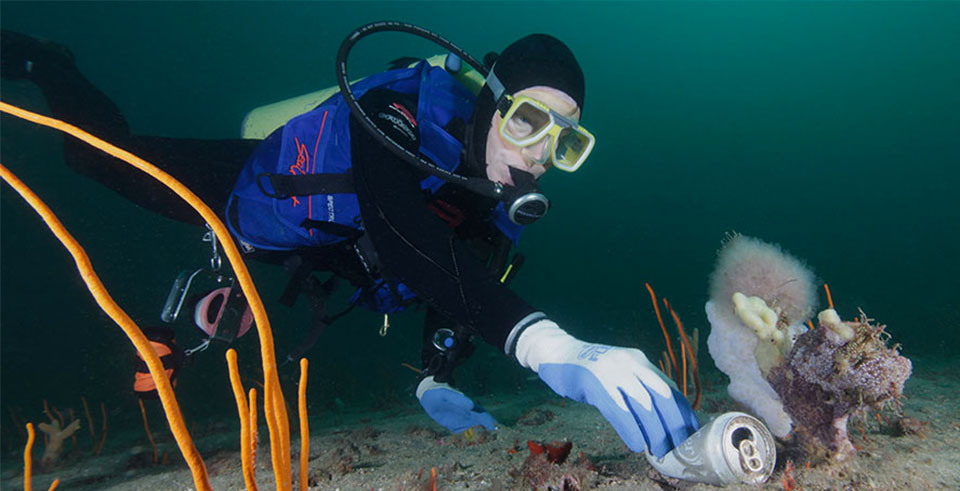Marine Debris
Gray's Reef

Why is it a concern?
Marine debris may be any object of wood, metal, glass, rubber, plastic, cloth or paper that has been lost or discarded in the marine environment. Debris can pose serious threats to marine wildlife via entanglement or ingestion, cause impairment of navigation by obstructing propellers and clogging cooling intakes, and negatively impact the aesthetic qualities of the sanctuary.
Use of Gray’s Reef sanctuary and surrounding areas has increased since the designation of the sanctuary in 1981. As coastal populations rise and boating, fishing and offshore shipping increase in the region, a rise in the volume of marine debris entering the waters of the sanctuary can be expected. A recent study by Kendall et al. (2007) showed that approximately two-thirds of all observed debris items found during field surveys was fishing gear, and about half of the fishing-related debris was monofilament fishing line. Other fishing related debris included leaders and spear gun parts, and non-gear debris included cans, bottles and rope. Debris was concentrated in the center of the sanctuary and most frequently associated with the ledges, which are essential fish habitat for the great diversity of fish found in GRNMS.
Research on marine debris within Gray’s Reef National Marine Sanctuary has focused on investigating the types of debris present, spatial distribution and abundance of debris and influence of ocean currents where marine debris is found. There have been no marine debris specific investigations since before the ban in spearfishing in 2009.
Overview of Research
| Project Name | PI and contacts | Links |
|---|---|---|
Characterization of the |
Matthew S. Kendall, Laurie J. Bauer and Christopher F.G. Jeffrey |
http://graysreef.noaa.gov/science/publications/pdfs/i-17.pdf |
Assessment and Monitoring of |
Science Needs and Questions
Marine Debris was identified as a pressure impacting the condition of biologically structured habitats and the quality of living resources in the Grays Reef Condition Report. It was also identified as an issue of concern in the Office of National Marine Sanctuaries’ National Condition Report.
- Are certain types of debris more likely to contain contaminants and can those be targeted for removal efforts?
- How do the types of debris found today differ from the study conducted in 2006?
- What are the sources, types and accumulation rates of marine debris within the sanctuary?
- How can we reduce the sources of debris that ends up in the sanctuary?
- What are the impacts to marine resources of removal activities?
- What tools are available to detect marine debris before it enters the sanctuary?
- Are the types of debris found in the RA different from those found in the rest of the sanctuary?
Education and Outreach Material
NOAA Marine Debris Program Education Materials
References
Ehler, R. and V.R. Leeworthy. May 2002. A Socioeconomic Overview of Georgia’s Marine Related Industries and Activities; NOAA, U.S. Department of Commerce.
Gittings, S.R., M. Tartt, and K. Broughton. 2013. National Marine Sanctuary System Condition Report 2013. U.S. Department of Commerce, National Oceanic and Atmospheric Administration, Office of National Marine Sanctuaries, Silver Spring, MD. 33 pp.
Kendall, M.S., L.J. Bauer and C.F.G. Jeffrey. 2007. Characterization of the benthos, marine debris and bottom fish at Gray’s Reef National Marine Sanctuary. Prepared by National Centers for Coastal Ocean Science (NCCOS) Biogeography Team in cooperation with the National Marine Sanctuary Program. Silver Spring, MD. NOAA Technical Memorandum NOS NCCOS 50. 82 pp. + Appendices.
NMSP (National Marine Sanctuary Program). 2006. Gray’s Reef National Marine Sanctuary Final Management Plan/Final Environmental Impact Statement. U.S. Department of Commerce, National Oceanic and Atmospheric Administration, National Marine Sanctuary Program, Silver Spring, MD. 260 pp.
NOAA (National Oceanic and Atmospheric Administration). 2008. Marine Debris Emergency Response Planning in the North-Central Gulf of Mexico Interim Draft Report. 44pp.
ONMS (Office of National Marine Sanctuaries). 2008. Gray’s Reef National Marine Sanctuary Condition Report 2008. U.S. Department of Commerce, National Oceanic and Atmospheric Administration, Office of National Marine Sanctuaries, Silver Spring, MD. 42 pp.

